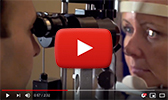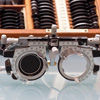Overview
iLASIK, LASEK and PRK are all refractive surgery techniques used to correct nearsightedness (myopia), farsightedness (hyperopia), astigmatism and presbyopia. All three surgical procedures are deemed safe and offer similar results and freedom from glasses and contact lenses in most situations.
Why Refractive Surgery?
Refractive error, or a need for glasses or contacts, comes in many forms. Nearsightedness, or myopia, is a condition in which people see close objects (such as print on a page) clearly but distant objects are not clear. Nearsightedness occurs if the eyeball is too long or the clear front cover of the eye (the cornea) has too much curvature. As a result, the light entering the eye isn't focused correctly.
Farsightedness, or hyperopia, is the opposite problem where distant objects can be seen clearly, but close objects appear blurred. Farsightedness occurs if the cornea does not have enough curvature or the eyeball is too short. Thus the light entering the eye is not focused correctly and close objects are not in focus.
Astigmatism occurs when the cornea is shaped more like a cylinder (such as the shape of a football) than a sphere (such as the shape of a basketball). As a result, people with astigmatism have blurred or distorted vision at any distance.
Finally, presbyopia begins to occur in most patients around the age of 40 when the lens begins to lose flexibility to focus on images at near. Similar to gray hair and wrinkles, presbyopia is a symptom caused by the natural course of aging.
All of the above conditions can often be treated well with glasses or contact lenses. Some patients, however, feel that glasses or contact lenses are inconvenient for various reasons and they choose to be evaluated for refractive surgery.
The evolution of refractive surgical procedures and techniques for vision correction has developed over the past three decades. As a result, there are many options to help you achieve freedom from glasses and contacts if you are deemed an appropriate candidate upon evaluation. Dr. Andrew Schwartz is an expert in multiple laser vision correction techniques. During your consultation, he will carefully evaluate your vision to determine if you are a good candidate, and then walk you through your options as well as the benefits and risks associated with each type of procedure. Dr. Schwartz takes a conservative approach with each patient to determine the best surgical option based on the safety profile and desired results.
What is Refractive Surgery
iLASIK iLASIK or intralase Laser Assisted in Situ Keratomileusis is another well known refractive surgery technique used to correct near-sightedness, far-sightedness, astigmatism and presbyopia. As compared to traditional LASIK which uses a sharp blade called a microkeratome, intralase is a completely bladeless all laser LASIK procedure which represents the most advanced technology available. In the iLASIK procedure a femtosecond laser is used to create a very thin and precise flap of the cornea. The flap is then lifted and a second laser (the same one used in PRK and LASEK) is used to reshape the cornea and eliminate refractive error. Finally, the flap is returned to its original position without sutures and acts as a natural bandage which allows a rapid and pain free recovery.
iLASIK or intralase Laser Assisted in Situ Keratomileusis is another well known refractive surgery technique used to correct near-sightedness, far-sightedness, astigmatism and presbyopia. As compared to traditional LASIK which uses a sharp blade called a microkeratome, intralase is a completely bladeless all laser LASIK procedure which represents the most advanced technology available. In the iLASIK procedure a femtosecond laser is used to create a very thin and precise flap of the cornea. The flap is then lifted and a second laser (the same one used in PRK and LASEK) is used to reshape the cornea and eliminate refractive error. Finally, the flap is returned to its original position without sutures and acts as a natural bandage which allows a rapid and pain free recovery.
https://www.ilasik.com/6000-all-about-ilasik.aspx
What are the advantages and disadvantages of LASIK?
The main advantage of LASIK is quick recovery time, as it is the fastest of all laser vision correction procedures. Most patients are able to see clearly within the first few days after surgery and many are able to drive the next day. Also, post surgical discomfort is minimal in comparison to PRK and LASEK.
Rare complications associated with the flap created during LASIK are considered a disadvantage to PRK where no flap is created and LASEK where only an epithelial flap is created. Also, patients with thin corneas may not achieve optimal results with a LASIK procedure. Finally, eye trauma after LASIK may dislodge the corneal flap, causing complications.
PRK
PRK or Photorefractive Keratectomy received FDA approval in 1995. It is a highly effective technique in which a microscopic layer of tissue (the epithelium) is removed from the surface of the eye before a highly specialized, precise laser reshapes the curvature of the cornea. When you reshape the cornea, it more precisely focuses light into the eye and onto the retina, providing clearer vision without the use of glasses or contact lenses. After the procedure, antibiotic and anti-inflammatory drops are applied, and a protective contact lens is placed in the eye for three to five days while the epithelium heals. PRK is a completely bladeless and flapless procedure.
What are the advantages and disadvantages of PRK?
Studies show that PRK, LASEK and LASIK produce similar outcomes in laser vision correction. Because PRK removes a layer of tissue instead of creating a flap in the tissue, there is no risk of surgical flap complications that may occur (rarely) with LASIK. This may be important for people who engage in activities that put them at risk for eye injuries. Also in cases in which a person's cornea may be too thin for LASIK surgery, PRK may be a good option. Nerve regeneration on the surface of the eye appears to occur faster with PRK, which can mean less dry eye or other complications during the healing process.
For the first few days after surgery, PRK causes more discomfort than LASIK, which can be effectively managed with medication. Vision will often continue to improve for several weeks after PRK but is usually excellent by 2 to 4 weeks post surgery.
PRK: During The Procedure
LASEK
LASEK or Laser Assisted Sub-Epithelial Keratomileusis is another refractive surgery technique in which a microscopic flap of epithelial tissue is created and moved out of the way before the laser is used to reshape the cornea. The epithelial layer is then replaced and used as a natural bandage to aid in the healing process. After the surgery, a protective contact lens is placed in the eye for three to five days while the epithelium heals.
What are the advantages and disadvantages of LASEK?
While LASEK offers less discomfort than PRK, the healing times are about the same. When comparing LASEK to LASIK, the flap of tissue created with LASEK is significantly thinner than that created during a LASIK procedure. Thus, flap related complications are minimized. Also, if the doctor establishes that a patient has a thin cornea, then LASEK may be a better option than LASIK, since the thickness of the flap is an important consideration.
Of the three procedures, LASIK offers the fastest healing time. Also, discomfort is higher with LASEK than with LASIK. With LASEK, patients usually see clearly four to seven days post surgery versus one to two days with LASIK.
LASIK: During the Procedure
How long does the procedure take?
Total procedure time for PRK, LASEK and LASIK take approximately five minutes per eye. The laser portion of the procedure takes less than one minute per eye.
What can I expect before and after surgery?
PRK, LASEK and LASIK are all outpatient procedures that take approximately one hour from start to finish. Before your procedure, you will relax in a reclined position and the doctor will apply anesthetic drops into your eyes to prevent any discomfort during your surgery. The surgical process takes about five minutes per eye. After the procedure, you will relax for a short period of time and then be released. It is recommended that you have someone with you to help you home, as your vision will be blurred when you leave. You may experience some scratchiness or discomfort after your surgery, which will be managed with medication. Dr. Schwartz will see you back the next day to check on your post-operative progress and answer any additional questions you may have. You will then return for a series of post-operative appointments as deemed necessary by the doctor. Fifth Avenue Associates is different from other surgical practices you may encounter. Dr. Schwartz himself performs all pre- and post-operative evaluations, and there is no co-management of your care with assistants or optometrists.
Refractive Surgery using Wave Front Technology
Wave front technology represents a new advance in refractive surgery in which a highly advanced diagnostic wave scan is taken of the eye. This scan can be thought of as a fingerprint of the eye's visual system. This information is then input into the laser where it can be directly translated onto the surface of the eye providing an individualized pattern of laser correction. This technology is available for most individuals and can be a significant advance in surgical outcomes. All patients are assessed for custom refractive surgery using wave front technology during their consultation.
VISX CustomVue Advantage
: The Fingerprint of Your Vision
Your vision is unique - as personal as your fingerprint or your DNA. WaveScan technology provides your eye doctor with a map of your eye.
Initially you will meet with Dr. Schwartz for a complete medical evaluation and eye history to determine whether you are a good candidate for the CustomVue procedure. He will also discuss the benefits and risks of the procedure with you. A corneal topographic measurement will then be taken to map the unique characteristics of your eye. With this map along with other diagnostic tests, Dr. Schwartz will be able to:
▪ Accurately assess whether you are a good candidate for laser vision correction
▪ Develop an individualized treatment plan to address your unique vision needs
Once it is confirmed that you are a good candidate, the doctor will schedule you for a CustomVue procedure.
On procedure day, you will be seated in a reclined position. Anesthetic drops will be placed in your eyes to prevent any discomfort and a flap will be created on your cornea if you have LASIK or LASEK or a layer of surface cells will be removed if you have PRK. Your individualized treatment information is transferred from the WaveScan to the laser in order to drive the CustomVue procedure. The actual laser procedure typically takes less than one minute, and most individuals feel no pain during the procedure.
After CustomVue, you will notice results immediately, and your vision will continue to improve over the next few days to weeks. Typically, you will be scheduled for a follow-up visit the next day, again in about a week, and again three weeks after the initial procedure.
Difference between LASIK and PRK


Fifth Avenue Associates
1034 Fifth Avenue
New York, NY 10028
Phone: 212-570-0707
Fax: 212-570-0555
Email: [email protected]

Dry Eye Syndrome
Cataracts
Droopy Eyes
Bags Under The Eyes
Ptosis
Ectropion/Entropion
Eyelid Cancers
Refractive Surgery
Thyroid Eye Disease
Tear Duct Conditions
Pediatric Eye Care
Blepharospasm

For contact details and patient forms please click below.

Your gift can help Virtue Foundation tackle critical issues and make a positive impact around the globe.

Click here to view and listen to the latest Fifth Avenue Associates audio/Video Clips